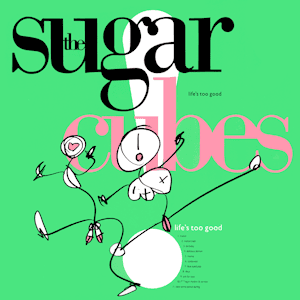Life’s Too Good arrived in 1988 as the first full-length album from The Sugarcubes, a group that formed in Iceland just a couple of years earlier. The band included musicians with deep roots in the local post-punk scene, but this release marked a shift from their more underground beginnings. It brought a sharper focus on pop structure, even as it kept a playful and sometimes chaotic spirit.
Rather than turning away from their past sounds, the album builds on them in unexpected ways. It fuses post-punk energy with catchy, off-kilter melodies and offbeat lyrics. The result is a collection of songs that feels both strange and accessible. While many bands in the late ’80s were moving toward darker or more polished sounds, The Sugarcubes carved out a space that was colorful, ironic, and unpredictable.
The breakout single “Birthday” caught attention far beyond Iceland. It received strong support from UK music press and helped launch the band into international awareness. It also introduced many listeners to the striking voice of Björk, whose mix of raw emotion and unusual phrasing made her an instant standout.
Sonic Exploration

The production on Life’s Too Good walks a line between polish and rawness. It doesn’t aim for the high-gloss finish typical of late ’80s pop albums, but it’s far from lo-fi. The sound is crisp enough to highlight each band member’s contributions, yet there’s an intentional rough edge that keeps things grounded. This slightly off-kilter production mirrors the band’s overall tone—energetic, playful, and a little chaotic. It also helps amplify the unpredictability that runs through the songs, making the listening experience feel alive and unscripted.
At times, the mix gives the vocals a sharp presence, placing Björk’s voice front and center, while allowing Einar Örn’s eccentric interjections to cut through with equal force. The rhythm section feels tight but not overproduced, giving the bass and drums just enough room to add momentum without overwhelming the rest.
Musical Arrangements
Instrumentally, the album is lean but inventive. The guitars often rely on spiky riffs and jangly tones, paired with punchy drums and elastic basslines. Keyboards appear in subtle moments, adding texture without taking focus. What really sets the arrangements apart is how they support the vocal dynamic between Björk and Einar. She delivers her lines with wild emotional swings—from childlike wonder to piercing intensity—while Einar responds with spoken-word rants or barked phrases that feel more like a counter-narrative than a harmony.
This tension in the vocal delivery creates a unique push and pull. Sometimes it works beautifully, especially on tracks like “Birthday,” where Björk’s voice dances through the melody with an otherworldly grace. Other times, Einar’s interruptions can feel distracting, depending on the listener’s taste. Still, the contrast is part of what gives the album its distinctive character.
Genre Elements
Musically, Life’s Too Good draws from a broad mix of styles. At its core, it belongs to the post-punk and alternative rock scenes, but it also carries strong traces of new wave, art pop, and even punk. There are moments that recall the angular rhythms of Talking Heads or the spunk of B-52s, yet the album never feels like a direct imitation. It borrows familiar tools, but rearranges them in its own odd, Icelandic way.
Lyrical Analysis

At first glance, the lyrics on Life’s Too Good might seem whimsical or nonsensical, but underneath their surreal surface lies a more nuanced view of human behavior and emotion. The album plays with themes like innocence, absurdity, miscommunication, and emotional volatility. Songs often explore the weirdness of relationships, the awkwardness of social norms, or the clash between inner thoughts and outer expression.
“Birthday,” for instance, spins a tale that feels part fairy tale, part psychological vignette. It captures the curiosity and awkwardness of youth, framed through cryptic, dreamlike imagery. Other tracks like “Coldsweat” and “Delicious Demon” dive into more manic territory, using fragmented language to mirror emotional instability or uncontrolled desire.
There’s no clear, overarching narrative across the album, but the themes repeat in unusual ways. The lyrics often return to contrasts—joy and discomfort, playfulness and menace—suggesting that life, while “too good,” is also full of contradictions.
Lyrical Depth
The band leans toward abstract and poetic writing rather than linear storytelling. Many lines feel like cut-up phrases or overheard thoughts stitched together in unexpected ways. This creates a feeling of spontaneity and strangeness. It can be hard to pin down a single meaning, but that ambiguity is part of what makes the lyrics interesting. They invite interpretation without giving easy answers.
While not every lyric lands with depth, some lines carry surprising weight when considered in context. Björk’s delivery gives even the most fragmented phrases an emotional charge, making the lyrics feel more profound than they might seem on paper.
Einar’s parts are more erratic—his spoken-word style can come off as humorous or disjointed—but they add another layer to the band’s lyrical palette. His words often feel like interruptions or internal commentary, adding tension and contrast to Björk’s more melodic expressions.
Emotional Impact
The lyrics on Life’s Too Good don’t aim to tug at the heartstrings in a conventional way. Instead, they evoke a strange mix of feelings—amusement, discomfort, curiosity, and even awe. Björk’s vocal interpretations bring out the emotional core of the songs, regardless of how abstract the words are. Her phrasing, tone, and sudden shifts in intensity make the lyrics feel lived-in and emotionally complex.
Cohesion and Flow

Life’s Too Good does not follow a strict narrative arc, but its sequence creates a journey that feels intentional in mood and pacing. The album opens with a burst of energy, plunging listeners into a world that’s both vibrant and unsettling. Songs like “Traitor” and “Motorcrash” set a fast, almost chaotic pace, while “Birthday” offers a moment of eerie calm and emotional depth early in the tracklist. This contrast creates a dynamic flow that keeps the listener engaged.
While the order of the songs doesn’t tell a linear story, the emotional shifts are paced well. Peaks of tension are followed by more melodic or subdued tracks, preventing the album from feeling one-note or overwhelming. Even when individual songs feel unpredictable, the overall progression feels carefully arranged to maintain interest without exhausting the listener.
By the time the album reaches its closing tracks, there’s a sense of winding down. “Delicious Demon” and “F***ing in Rhythm and Sorrow” bring back a darker, more reflective tone. It’s a subtle comedown that doesn’t resolve everything, but it gives the record a rough shape—more like a collage than a story, but still satisfying.
Thematic Consistency
The album maintains a strong thematic and stylistic identity throughout. Its blend of absurdist humor, emotional rawness, and genre-blurring production stays present from start to finish. Even as the songs vary in tempo and tone, they all share a sense of unpredictability and surreal charm.
That said, the abrupt shifts in vocal delivery—especially between Björk’s expressive singing and Einar’s spoken parts—can be jarring. Some tracks feel more unified than others, and there are moments where the interplay between the two vocalists might feel disjointed. For some listeners, this may add to the album’s character; for others, it could interrupt the sense of cohesion.
Standout Tracks and Moments
Birthday
“Birthday” remains the undeniable centerpiece of Life’s Too Good. It’s the track that first drew international attention, and for good reason. Musically, it’s both haunting and beautiful, built around a simple, circling guitar line and airy textures that feel dreamlike. What really elevates it is Björk’s vocal performance—by turns delicate, raw, and ecstatic. Her voice carries the song’s odd lyrics into a place of real emotional weight. It captures a kind of innocence tinged with danger, which sums up the band’s style in a single track.
Motorcrash
“Motorcrash” is another highlight, offering a blast of absurd energy. Its lyrics tell a twisted tale of love through motorcycle accidents, with a strangely cheerful tone that undercuts the dark subject matter. The contrast between Björk’s excited delivery and the grim imagery gives the song a surreal charm that sticks with you.
Delicious Demon
“Delicious Demon” stands out for its rhythm and vocal interplay. The song leans more heavily into funk and post-punk grooves, with Einar taking a more prominent role. While his presence can divide opinion, this track showcases how the duo’s strange chemistry can work when everything clicks. The song is aggressive and strange, but undeniably memorable.
Memorable Moments
One of the most unforgettable moments comes midway through “Birthday,” when Björk’s voice leaps into a high, sustained note that seems to break through the track’s dreamlike calm. It’s a pure emotional release, unfiltered and arresting. That moment alone captures the album’s ability to merge fragility with intensity.
Another strong moment happens in “Coldsweat,” where the manic tempo and chaotic instrumentation suddenly lock into a sharp groove. It’s a track full of nervous energy, and the shift into a tighter rhythm gives it a jolt of clarity that feels thrilling.
The outro of “Mama” also deserves mention. It’s one of the more subdued pieces on the album, and its closing moments slow things down into a moody haze. It’s not the most immediate track, but it reveals a more introspective side of the band, rounding out the emotional spectrum of the record.
Artistic Contribution and Innovation

When Life’s Too Good landed in 1988, it didn’t just introduce The Sugarcubes—it announced that Iceland had something entirely original to offer the global music scene. At a time when alternative rock was still carving out its identity, this album felt like an outlier in the best way. It didn’t slot neatly into any specific genre. It was too melodic to be punk, too chaotic to be pop, and too whimsical to fit into the darker corners of post-punk. Yet it was embraced by alternative audiences and critics alike.
In the broader landscape, the album stood out for its refusal to follow trends. While many bands in the late ’80s leaned into polished production and more market-friendly songwriting, The Sugarcubes took a different path. They brought art-punk eccentricity into the spotlight, but wrapped it in enough melody and charm to make it accessible. Their success helped pave the way for other non-mainstream acts to find global audiences, especially those coming from outside the dominant music hubs.
More significantly, Life’s Too Good laid the groundwork for Björk’s later solo career. Her unique voice and artistic presence were already clear here, and the album’s visibility gave her a platform that would grow into something much larger. In that sense, the album’s influence ripples far beyond its own tracklist.
Innovation
What makes Life’s Too Good innovative isn’t any one technique—it’s the way it combines familiar elements in strange, striking ways. The blend of punk rawness with avant-pop melodies was not entirely new, but the band’s specific take on it felt unlike anything else at the time. The dual-vocal approach, with Björk’s emotional range contrasted by Einar’s spoken-word oddities, added a layer of unpredictability that was rare in pop or rock.
Lyrically, the album dared to be surreal without losing its emotional core. Its themes were indirect, its stories fragmented, yet the songs never felt hollow. They created a world that was funny, sad, and slightly unhinged—all at once.
Even the production choices, which leaned away from studio slickness, gave the album a vibrant, unfiltered edge. It sounded alive, even when it was messy. That sense of imperfection became part of its charm, helping to shift expectations of what an alternative album could be.
Closing Thoughts

Life’s Too Good is a bold and eccentric debut that captures lightning in a bottle. Its strengths lie in its fearless approach to sound, its surreal lyrical world, and the dynamic contrast between its two vocalists. The album doesn’t try to fit in—it thrives on standing apart, mixing raw emotion with absurdist humor and delivering it all through unconventional song structures.
At its best, the album is exhilarating. Tracks like “Birthday” and “Motorcrash” showcase a band that knows how to balance strangeness with sincerity. The production, while rough around the edges, suits the music’s unpredictable spirit. Björk’s vocals are a clear highlight—wild, expressive, and emotionally charged—while Einar’s contributions add a polarizing but undeniably unique texture.
Still, the album isn’t without its flaws. There are moments when the vocal interplay feels more disruptive than complementary, and not every track hits with the same intensity. Some listeners may find the sudden shifts in tone and delivery hard to follow. But even its imperfections are part of what makes the album memorable. It’s an experiment that mostly pays off, and when it does, it does so in spectacular fashion.
In terms of legacy, Life’s Too Good was more than a successful debut—it was a cultural export that put Icelandic music on the map and introduced the world to one of its most distinctive voices. It remains a standout release from the late ’80s alternative scene, not just for its sound, but for its spirit.
Official Rating: 8/10
This rating reflects the album’s originality, emotional impact, and lasting influence. While not perfect, it’s a rare example of a debut that manages to be both groundbreaking and deeply personal. Its quirks might not appeal to everyone, but for those willing to embrace its oddities, Life’s Too Good offers a rich and rewarding listen.
